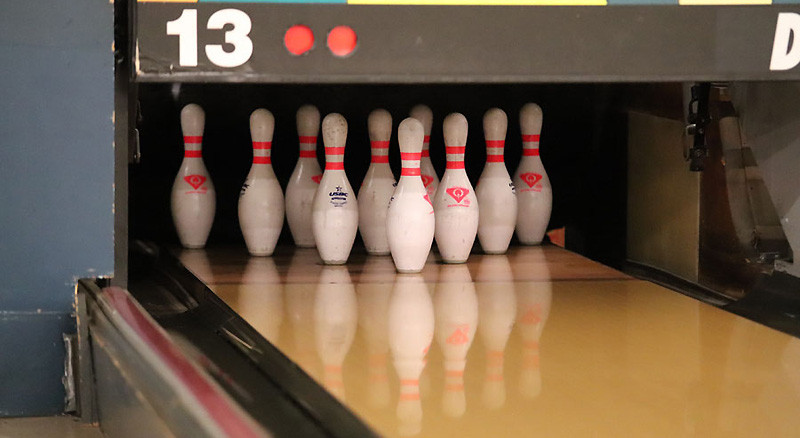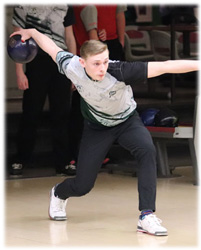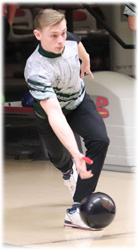


MHS - Bowling / February 27, 2020 By JD Titus
Generally speaking, sports get plenty of attention, even by people who do not follow sports. This being said, there are some sports that do not receive the same amount of consideration. For many people, bowling is nothing more than a fun night out with friends. However, for a select few, bowling is much more than that. The game can be described as strategic, planned, and adaptive. With as many technicalities as bowling has, it is far more complex than the average person would believe. Unbeknownst to many, bowling is a game that is full of depth, strategy, and terminology.
The first thing that casual bowlers do when entering the alley is to rent shoes and pick out a ball. What these bowlers do not realize is that competitive bowlers personally own many of the things that bowling alleys provide to them, and much more. For example, most bowlers have their own shoes and may have two to three bowling balls with them at the alley. The typical bowler will also have bowling bags to tote their belongings, rags to clean their balls, and various tools to help adjust their shot. A rosin bag is a very important tool to use in many sports, such as baseball or gymnastics, and bowling is no exception. If the bowler drops their ball early, they may choose to use some powder from this bag to increase their grip. Another tool used to help improve a bowler’s shot is a ball cleaner. Ball cleaners are typically used to get the oil from the lane off of the ball to increase the ball’s friction. However, there are some rules that you must follow when using cleaners. According to the Professional Bowling Association [PBA], cleaners can not change the ball and must be approved by the PBA. Some bowlers even go as far as sanding or polishing their balls. In doing this, the bowler is attempting to change the way in which the ball reacts to the wood and oil on the lane. This adjustment can only be understood with basic knowledge of the anatomy of a bowling ball.
The most important part of any arsenal is the bowling ball, which has two main components. The first component is the coverstock. The coverstock is typically made of plastic, urethane, or reactive resin. These different coverstocks have different reactions to the oil on the lanes. This is an important factor when choosing a bowling ball. Don Nace states in Bowling for Beginners, “One way to characterize coverstocks is by the terms highly aggressive, aggressive, and mellow” (70). Highly aggressive means that the ball will hook to the pins with more force, while mellow means that the ball will have very little hook. Although the coverstock is highly important when choosing a ball, the surface of the ball can still be altered by applying sandpaper or polish to the ball. Rough surfaces have a greater amount of friction than smooth surfaces. This means that bowling balls with rough surfaces are best used on lanes with large amounts of oil; on the other hand, balls with a smooth surface are better suited for lanes with a smaller amount of oil.
The other component of the ball is the core. The core is the inner portion of the ball that allows the ball to produce more or less hook. All cores come in various shapes and sizes, changing the strength and shape of the hook. The main two types of cores are symmetrical and asymmetrical. If a ball has a symmetrical core, it will have a smoother hook throughout the lane; on the other hand, asymmetric cores will provide a more aggressive hook on the back end of the lane. There is a link between which coverstocks and cores a bowler prefers and the style of bowling they demonstrate.
There are various types of bowling styles, each with their own play style and preferences. The two main types of bowlers are the power player and the stroker. The largest distinction between these two types of shooters is the amount of power and angle in their shot. Power players, also known as "crankers", have a strong shot with quick speeds and will shoot the ball with a great angle on the lane. These bowlers often lack the accuracy that strokers possess but make that sacrifice for more pin action. This power is generated by the placement of the hand and the stressed rotation of the wrist. If the hand is more open rather than cupped during the backswing, the bowler will typically provide more revolutions. The wrist will quickly rotate in a counterclockwise motion to provide for more torque on the shot (Jowdy 49). Strokers are on the opposite end of the spectrum. They focus more on the accuracy of the shot rather than a large amount of hook. The angle of a stroker shot is more effective than that of a power player. This is true because the ball is more likely to leave the seven and ten pins when playing with a wider angle. The more direct angle that strokers use is simple, yet effective. It is even apparent in PBA statistics that strokers have much more consistency in their games (Jowdy 50). Arguably, the most complicated portion of the shot is the approach, which is the movements leading up to the bowler releasing the ball for their shot. The logic behind this is that a bowler’s approach has endless possibilities. The number of factors that make a good approach can seem inconceivable. Anything from the number of steps to take, the speed at which the bowler should move, the rhythm of the backswing in coordination with the steps can affect the outcome. For these reasons, the approach is highly difficult to master.
Arguably, the most complicated portion of the shot is the approach, which is the movements leading up to the bowler releasing the ball for their shot. The logic behind this is that a bowler’s approach has endless possibilities. The number of factors that make a good approach can seem inconceivable. Anything from the number of steps to take, the speed at which the bowler should move, the rhythm of the backswing in coordination with the steps can affect the outcome. For these reasons, the approach is highly difficult to master.
The first thing to consider about the approach is the number of steps to take. The traditional walk has four steps that, for a right-handed bowler, is a right step, left step, right step, and a final left step. On the first step, the bowler should push the ball straight out from their body, towards the pins. The second step should have the ball swinging naturally in a pendulum-like motion. During this time, the ball should be passing by the bowler’s side, away from the direction of the pins. Then, for the third step, the ball should be at the highest point of the backswing, preparing to unload the ball for the fourth and final step. For the last step, the ball should swing naturally past the bowler’s side for the second time, but this time going forward. This step will need to be planted firmly on the lane to allow for the slide. This slide allows the bowler to maintain balance and momentum. Again, the four-step approach is the traditional approach(Mullen 24). A more modern style is the five-step approach. The five-step shares many characteristics with the four-step. The only difference is that this approach begins on the left foot. The ball does not get pushed away from the body until the second step of the five-step. Many bowlers use this approach because it simply feels more natural to them than the four-step. However, the main purpose for the implication of a fifth step is used to start the momentum of the approach early. This slight increase in speed will allow the bowler to use a more direct shot towards the pocket of the pins (Mullen 26).
A more modern style is the five-step approach. The five-step shares many characteristics with the four-step. The only difference is that this approach begins on the left foot. The ball does not get pushed away from the body until the second step of the five-step. Many bowlers use this approach because it simply feels more natural to them than the four-step. However, the main purpose for the implication of a fifth step is used to start the momentum of the approach early. This slight increase in speed will allow the bowler to use a more direct shot towards the pocket of the pins (Mullen 26).
Kael “Leak” Titus bowled for most of his life. During his high school years, Leak became very successful in the sport. He was the first male bowler in Mulvane to earn a medal at the state competition. On top of that success, he also set the school record for high series with a score of 737. He bowled this series at The Alley in Wichita, Kansas, making it his favorite alley in which to bowl. His style of choice was a stroker, due to the amount of control he felt while he was on the approach. Knowing this, Kael chose the Phaze II as his ball of choice. This ball was symmetrical, allowing Kael to play on many different parts of the lane. When asked about his success, Kael attributed it to his hard work and practice. He spent at least five days a week practicing for several years, up until the state tournament. When asked what advice he would offer to a new bowler, Kael stated, “Do not allow yourself to get discouraged when you hit a slump.” For several years, Kael struggled with his mentality. However, Kael is not the only one to experience this problem. Many are affected by an entirely different part of bowling: the mental game.
A bowler can only be as strong as their mind will allow. Similar to other aspects of life, a solid mental game is imperative to any sort of bowling success. Negative thoughts will not assist the bowler in developing skills. A key point is that the bowler focuses on the execution of the shot rather than the outcome. If the shot goes exactly where it was supposed to, yet it still did not strike, then the bowler must adjust. Adjustment is what separates a good bowler from a great bowler. Another vital part of the mental game is not allowing the mind to get overwhelmed. It is highly important to maintain a level mind while actively participating. In most cases, the bowler that gets angry or frustrated is also the bowler who loses. Finally, confidence is also a significant factor in bowling well. Confidence is what allows bowlers to convert difficult spares or set a new personal record. Overall, the mental game is almost like an entirely separate game from bowling itself (Jowdy 1-9).
Although things like the ball, the approach, and the mental game are important, there are still other factors of bowling that casual bowlers may not know or understand. For instance, if two are on the approach simultaneously, it is widely accepted that only one bowler will go at a time. This is called “lane etiquette.” It is considered impolite to get on the approach if another bowler is already on their approach.
Another thing to consider is the cost of bowling. Many bowling balls will average at around $200. Not only this, but bowling bags that carry three balls average around $150. Therefore, if a bowler has three balls and a three-ball bag, the price is already around $750. This is not even considering rosin bags, tape for your hands, shoes, or a towel for cleaning the ball. Taking into account all expenditures, the new total is around $830-$840. However, the largest cost comes as a result of practice. If a bowler practices five days a week, three games a day, and two dollars a game, the total for practice reaches about $1,440 a year. This plus the arsenal for the average bowler brings the grand total to about $2,270 annually. These prices make it apparent that bowling is not nearly as inexpensive as one may think.
Additionally, when the bowling ball travels down the lane, there is a substance that covers the lane. The substance is viscous liquid known as “oil”. The oil on the lane determines how far a ball can go down a lane without hooking. It reduces the amount of friction on the lane, allowing for the ball to roll and slide at the same time. The oil is also laid out in what is called “oil patterns”; therefore showing that there are different ways for the oil to be distributed on the lane. If a lane has a greater amount of oil, the bowler will want to have a straighter shot. On the other hand, if a lane has a small amount of oil, the bowler will be forced to shoot a greater angle if they wish to be successful. Not only this, but the oil will redistribute as the balls push it around. This change is the largest factor that makes bowlers adjust. Having to adjust in this manner is no easy task and further proves that bowling is not as simplistic as it may seem.
Bowling is a sport composed of many different aspects that are not outwardly obvious to those who do not regularly participate. Things such as equipment, styles of bowling, the approach, the mental game, and cost are all points that many do not consider when they think of bowling. These aspects make bowling much more than a game. Bowling is a complex machine with many parts that are widely unconsidered.
Works Cited
“Equipment Specifications and Certifications Manual.” Professional Bowling Association,
PBA, 2019, PBA.com.
Jowdy, John. Bowling Execution. Human Kinetics, 2009.
Mullen, Michelle. Bowling Fundamentals. Human Kinetics, 2004.
Nace, Don. Bowling for Beginners: Simple Steps to Strikes & Spares. Sterling Publishing
Company, 2001.
Titus, Kael. Personal interview. 10 Nov. 2019.
